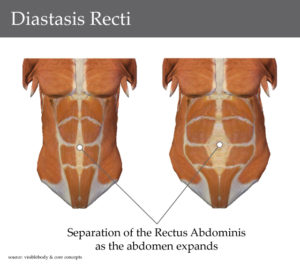BYD Blog
Losing your Mom Belly: What is Diastasis Rectus Abdominis?

What is Diastasis Rectus Abdominis?
Diastasis Recti awareness is a mission for me. Both men and women can be affected by it, however, the demands from pregnancy can make it worse or even cause lifetime health implications.
For pregnant women, the short-term effects of Diastasis Recti include a ‘mom belly’, poor posture, and back pain. Long-term weak Diastasis can learn to hernias, breech babies in future pregnancies, and long-term ambulation issues. With that in mind, I hope you enjoy this guest blog from Restore Motion on Diastasis Recti.
Most people know that the abdominal muscles can be toned and displayed as a “six-pack.” Fewer people know that the same muscles can also separate from each-other, right down the midline, forming a diastasis rectus abdominis (DRA).
Diastasis means separation. Rectus abdominis refers to muscles that make up part of the abdominal layer closest to the skin. They are the vertically oriented muscles in the picture above, comprised of a right and left side. The two strips of muscle are connected to each other by connective tissue (fascia). In the formation of a diastasis rectus abdominis, the connective tissue stretches and the muscles elongate.

Q: What are the Risks Associated with Having a Diastasis Rectus Abdominis?
A: Increased risk of injury to your back from decreased core support.
Muscles function best at an optimal length. If the rectus abdominis muscles are asked to work in an over-stretched position as in a DRA, they will not contract as efficiently. The result is less core support of your spine and pelvis. Decreased core strength or core muscle imbalance is associated with a risk of injury, especially to your back.
In addition to the risk of injury, some people simply dislike the appearance of a protruding abdomen.
How can a Diastasis Rectus Abdominis Form?
- Improper lifting techniques and chronic straining (with lifting or to move bowels)
- Pregnancy
- Significant weight gain
- Weakened abdominal muscles or connective tissue disruption from surgery
- Idiopathic, born with it
What can be done about a Diastasis Rectus Abdominis?
Treatment options include physical therapy, wearing an abdominal brace, or surgery.
Physical therapy treatment for Diastasis Recti may include the following:
- Identification of movements and postures that exacerbate the DRA and education on how to avoid or modify these factors. This includes education on proper lifting/carrying/lowering body-mechanics.
- Exercise prescription focused on helping the rectus abdominis muscles activate as well as balancing the strength and coordination of deep core muscles (e.g. pelvic floor muscles, transverse abdominis, multifidi, and diaphragm).
- Resolution of myofascial trigger points in the core musculature
- Abdominal taping or belly binding to bring the rectus muscles back aid optimal length for function
Appropriate treatment will depend on the severity of the separation and how long it has been that way.
Consult your medical team to determine if you have a diastasis rectus abdominis and what is the best approach to treat it.
Written by: Claire Agrawal, PT, DPT
Originally posted at http://restoremotion.com/what-is-diastasis-rectus-abdominis/
Photo credits: Diastasis Rectus Abdominis: http://www.applehealthwellness.com/wp-content/uploads/2013/11/diastasis-recti.jpg
Amazon Affiliates
Click here to visit an Amazon list crafted by our students and clients for parents approved books and props for pregnancy through infancy.
